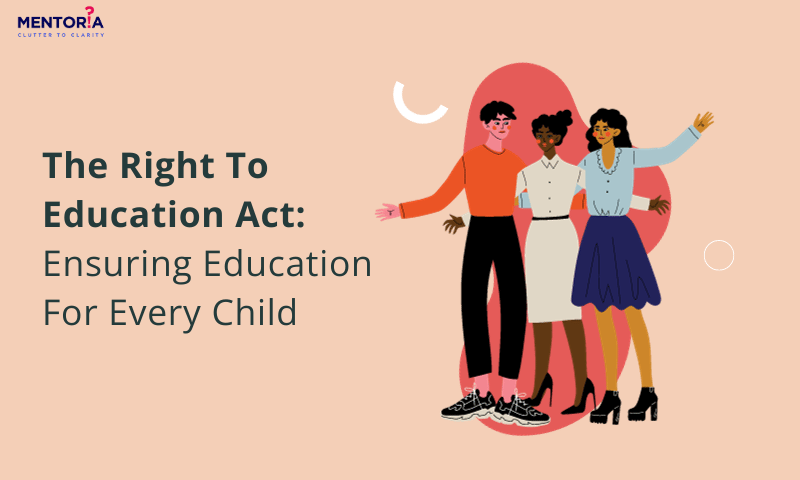The Right To Education Act: Ensuring Education For Every Child

Jump to Section
Education is a fundamental right, a stepping stone towards a brighter future. In India, the Right to Education Act (RTE), enacted in 2009, stands as a beacon of hope, promising quality education for every child. It’s not just a law; it’s a lifeline that connects the dreams of millions of children to the reality of classrooms.
Imagine a world where every child has access to quality education, regardless of their background, economic status, or location. The RTE Act aims to transform this vision into reality. In this blog, we’ll embark on a journey through the realms of education, exploring the significance, impact, and challenges of the Right to Education Act. Join us as we unravel this remarkable initiative, one that shapes the destiny of our nation’s youth.
The Right To Education Act: A Groundbreaking Legislation
The Right to Education (RTE) Act, passed in 2009, marked a watershed moment in India’s educational history. By making education a fundamental right for children aged 6 to 14, it brought about a revolutionary change. The Act not only guarantees access to schools but also regulates norms and standards for the provision of quality education.
One of its most transformative aspects is the requirement for private schools to allocate a percentage of their seats to children from economically disadvantaged backgrounds, ensuring that children from all strata of society have equal access to education. This provision has paved the way for social inclusivity and has been instrumental in breaking down barriers that previously limited educational opportunities.
The Right to Education Act, implemented in 2010, marked a paradigm shift. Statistics indicate a substantial increase in enrollment rates post-RTE. In 2005-06, the gross enrollment rate was 96.7%, while in 2016-17, it rose to 99.2%, showcasing the impact of this legislation.
Through the RTE Act, the government has committed to providing free and compulsory education, making it a constitutional obligation. This monumental shift in policy has not only opened the doors of opportunity for millions of children but has also set India on a path toward a more equitable and educated future.
Bridging The Gender Gap: Empowering Girls
The RTE Act has played a pivotal role in addressing and reducing the gender gap in education, particularly in rural and marginalised areas. Before the Act, girls faced multiple barriers to accessing education, including societal norms, economic constraints, and safety concerns. However, with the RTE Act ensuring free and compulsory education for all children, regardless of gender, girls have seen a significant increase in enrollment rates.
One of the most notable impacts of RTE has been the rise in the literacy rate among girls, especially in regions where female education was traditionally neglected. This shift is not only empowering for individual girls but also has broader societal implications. Educated girls are more likely to delay marriage, have fewer children, and actively participate in the workforce, contributing to the overall development of their communities and the nation.
The Act’s focus on providing a safe and inclusive learning environment has also encouraged parents to send their daughters to school without fearing for their well-being. This has been a crucial step in promoting gender equality and breaking the cycle of gender-based discrimination in education.
Quality Education: A Right, Not A Privilege
The RTE Act not only emphasises access to education but also underscores the importance of quality education. It sets specific norms and standards for school infrastructure, teacher qualifications, and pupil-teacher ratios. By doing so, it ensures that children not only attend school but also receive a meaningful and effective education.
Before the RTE Act, many children, particularly those in rural areas, attended schools with inadequate facilities and poorly trained teachers. The Act changed this landscape by mandating that schools meet minimum infrastructure requirements, which include classrooms, libraries, toilets, and safe drinking water facilities. This shift has created a more conducive learning environment and has had a positive impact on student engagement and outcomes.
Ensuring quality education for all is a key objective. However, a UNESCO report highlights that globally, over 617 million youth lack basic mathematics and literacy skills. In India, RTE has been instrumental in improving learning outcomes, but challenges remain in ensuring consistent quality.
Moreover, the Act insists on well-qualified teachers who undergo regular training, ensuring that students are taught by educators who are equipped to deliver quality education. This emphasis on teacher quality has been instrumental in enhancing the learning experience for children across the country.
Inclusivity: Education For All
Inclusivity lies at the heart of the RTE Act. One of its most remarkable provisions is the requirement for mainstream schools to admit and accommodate children with disabilities. This commitment to inclusive education recognises that every child, regardless of their physical or intellectual abilities, has the right to learn alongside their peers.
Before the RTE Act, many children with disabilities faced segregation and exclusion from the education system. They were often sent to special schools that were ill-equipped to provide a comprehensive education. However, the Act mandates that schools make reasonable accommodations to support the learning needs of children with disabilities, creating a more inclusive and diverse learning environment.
This shift toward inclusive education not only benefits children with disabilities but also fosters empathy and understanding among all students. It sends a powerful message that differences are to be celebrated and that everyone deserves an equal opportunity to learn and grow.
Challenges On The Path: Infrastructure And Teacher Shortages
While the RTE Act has made significant strides in transforming India’s education system, it hasn’t been without its share of challenges. One of the primary hurdles is the shortage of infrastructure and qualified teachers, especially in rural and remote areas.
Meeting the infrastructure requirements outlined in the Act, such as the provision of safe and functional school buildings, libraries, and sanitation facilities, has been an ongoing challenge for many states. Additionally, ensuring an adequate pupil-teacher ratio remains a concern, particularly in densely populated regions.
Challenges persist, notably in terms of infrastructure and teacher shortages. As of 2019, India faces a shortage of around 1 million teachers in elementary schools. Addressing these challenges is imperative to fulfil RTE’s vision of quality education.
Qualified teachers, trained to deliver quality education, are the backbone of any education system. However, recruiting and retaining well-trained educators in remote and economically disadvantaged areas has proven to be a persistent challenge.
Addressing these challenges requires a concerted effort from government authorities, civil society, and communities. The goal is to ensure that the benefits of the RTE Act reach every child, regardless of their geographical location.
Impact Of RTE: A Glimpse Of Progress
The impact of the RTE Act is tangible and promising. Enrollment rates have seen a substantial increase, particularly among marginalised communities. This signifies that the Act has succeeded in breaking down barriers that previously prevented children from attending school. Furthermore, the Act has contributed significantly to the reduction of the dropout rate among disadvantaged groups. By providing free and compulsory education, it has removed a significant financial burden from families and encouraged parents to send their children to school.
Additionally, there is a growing awareness and demand for quality education among parents and communities. This, in turn, has put pressure on schools and authorities to improve infrastructure and teaching standards, ensuring that the Act’s vision of quality education is realised.
The RTE Act has not only transformed the educational landscape but has also ignited a collective consciousness about the importance of education for every child.
The Road Ahead: Strengthening The Foundation
As India moves forward, the RTE Act remains a critical instrument for change. It is not merely about sending children to school but ensuring that they receive a holistic and quality education. This requires continuous efforts to address the challenges, improve infrastructure, and enhance teacher training.
Furthermore, the Act’s implementation must be monitored closely to ensure that its benefits reach every corner of the country. Collaborative efforts between government bodies, educators, parents, and civil society organisations are essential to strengthen the foundation of the RTE Act.
The Act embodies a promise—a promise to India’s children, promising them a brighter future through education. Together, we can turn this promise into a reality, illuminating the path toward a more educated, empowered, and equitable India. The journey continues, and as a nation, we must remain committed to this transformative cause.
Learn With Mentoria!
In the vast tapestry of a nation as diverse as India, the Right to Education Act stitches together a brighter future. It’s a reminder that every child, regardless of their circumstances, deserves a chance to learn, dream, and succeed. RTE has made remarkable strides in breaking down barriers to education and promoting inclusivity.
While challenges remain, the progress is undeniable. As we celebrate the successes of the RTE Act, let’s also renew our commitment to overcome the remaining obstacles. Let’s work together to ensure that every child in India not only has the right to education but also the opportunity to thrive.
We’re here to provide you with all the help! Kick-start your journey with Mentoria and discover the right fit for you. Feel free to call us to speak to our career mentors and choose the right guidance plan that suits your needs.
Mentoria’s career guidance programme enables you to choose your perfect fit from 3 streams, 850+ courses, and 12,000+ careers, and discover what will bring out the best in you.









